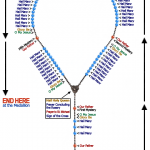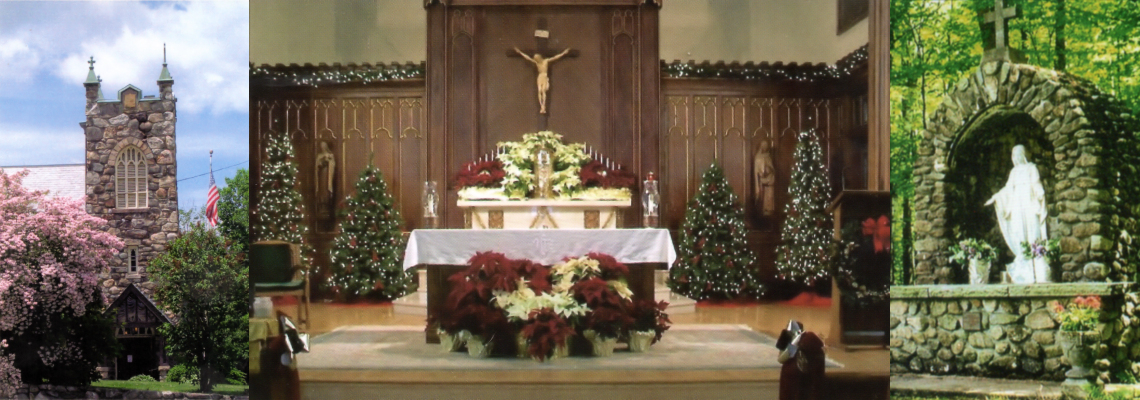“The Most Holy Rosary of the Blessed Virgin Mary”, as called is “Our Mother’s Prayer” as requested by Her. It is a “Voyage of Prayer” through Her Son’s life, witnessed through her eyes.
Twenty (20) major sequential events (mysteries) are defined and grouped into four (4) groups of five (5) mysteries each. These mystery groups develop Christ’s life though His childhood, ministry, Passion and Resurrection. We contemplate/meditate upon each individual mystery through repetitive prayer, deepening our scriptural voyage and understanding.
Click on the image below to expand it. What would initially seem to be complex is merely five (5) ten (10) repetitions with introduction and closing prayers for each mystery and the whole Rosary. It uses the “Sign of the Cross“, “The Apostles Creed“, the “Our Father“, the repetitive “Hail Mary“, the “Glory Be“, the “O My Jesus” (Fatima Prayer) and the “Hail, Holy Queen“. (These expanded prayers can be found elsewhere on this site.)
 You start at the Crucifix by making the Sign of the Cross, announce your petition, etc. When you announce the First Mystery and say the Our Father, you then go counter-clockwise (although clock-wise is acceptable as beads are in same order) SKIPPING the large bead that attaches the Crucifix section to the ‘loop’ and start on the 10 beads.
You start at the Crucifix by making the Sign of the Cross, announce your petition, etc. When you announce the First Mystery and say the Our Father, you then go counter-clockwise (although clock-wise is acceptable as beads are in same order) SKIPPING the large bead that attaches the Crucifix section to the ‘loop’ and start on the 10 beads.
There are several “Mysteries of the Rosary” one would say on any certain customary day and here summarized (in logical order):
Joyful Mysteries (Monday & Saturday)
- The Annunciation — Mary learns that she has been chosen to be the mother of Jesus.
- The Visitation — Mary visits Elizabeth, who tells her that she will always be remembered.
- The Nativity — Jesus is born in a stable in Bethlehem.
- The Presentation — Mary and Joseph take the infant Jesus to the Temple to present him to God.
- The Finding of Jesus in the Temple —Jesus is found in the Temple discussing his faith with the teachers.
The Joyful Mysteries are marked by the joy radiating from the event of the Incarnation. This is clear from the very first mystery, the Annunciation, where Gabriel’s greeting to the Virgin of Nazareth is linked to an invitation to messianic joy: “Rejoice, Mary.” The whole of salvation … had led up to this greeting. -Saint John Paul II, Oct 16, 2002
Luminous Mysteries (Thursday)
- The Baptism of Jesus in the River Jordan — God proclaims that Jesus is his beloved Son.
- The Wedding Feast at Cana — At Mary’s request, Jesus performs his first miracle.
- The Proclamation of the Kingdom of God — Jesus calls all to conversion and service to the Kingdom.
- The Transfiguration of Jesus — Jesus is revealed in glory to Peter, James, and John.
- The Institution of the Eucharist — Jesus offers his Body and Blood at the Last Supper.
Moving on from the infancy and the hidden life in Nazareth to the public life of Jesus, our contemplation brings us to those mysteries which may be called in a special way “mysteries of light.” Certainly, the whole mystery of Christ is a mystery of light. He is the “Light of the world” (Jn 8:12). Yet this truth emerges in a special way during the years of His public life. -Saint John Paul II, Oct 16, 2002
Sorrowful Mysteries (Tuesday & Friday)
- The Agony in the Garden — Jesus prays in the Garden of Gethsemane on the night before he dies.
- The Scourging at the Pillar — Jesus is lashed with whips.
- The Crowning With Thorns — Jesus is mocked and crowned with thorns.
- The Carrying of the Cross — Jesus carries the cross that will be used to crucify him.
- The Crucifixion — Jesus is nailed to the cross and dies.
The Gospels give great prominence to the Sorrowful Mysteries of Christ. From the beginning, Christian piety, especially during the Lenten devotion of the Way of the Cross, has focused on the individual moments of the Passion, realizing that here is found the culmination of the revelation of God’s love and the source of our salvation. -Saint John Paul II, Oct 16, 2002
Glorious Mysteries (Wednesday & Sunday)
- The Resurrection — God the Father raises Jesus from the dead.
- The Ascension — Jesus returns to his Father in heaven.
- The Coming of the Holy Spirit — The Holy Spirit comes to bring new life to the disciples.
- The Assumption of Mary — At the end of her life on earth, Mary is taken body and soul into heaven.
- The Coronation of Mary — Mary is crowned as Queen of Heaven and Earth.
“The contemplation of Christ’s face cannot stop at the image of the Crucified One. He is the Risen One!” The Rosary has always expressed this knowledge born of faith and invited the believer to pass beyond the darkness of the Passion in order to gaze upon Christ’s glory in the Resurrection and Ascension. … Mary herself would be raised to that same glory in the Assumption. -Saint John Paul II, Oct 16, 2002
Each Mystery bead on that given day is in numerical order above. As one says the Hail Mary on each of that decade’s rosary beads the current Mystery is mediated upon (yes, you’re doing two things at once). There is a website that one can practice on called “Come Pray the Rosary“. After selecting your language, you can choose “Individual” or “Worldwide”. This is a basic Rosary which has video, audio and the prayers written out which you speak or internally speak the prayers along with. It automatically selects the correct Mystery for the day. The Wordwide Rosary selection’s petition is for World Peace, but you can also add your own petition. This is a continual Rosary, so if you choose ‘Wordwide’ and find yourself partway into the Rosary you can skip back in at a later period to see if it’s restarted. The webmaster highly recommends starting here until you get comfortable.
The ‘basic’ Rosary noted above is good to begin with as just noted above. There is also the ‘scriptural’ Rosary (or Traditional) which takes more time (and many consider more satisfying) and is much easier to reflect upon the Mysteries by. Upon each Mystery, each of the 10 Hail Mary beads has a descriptive sentence that is also said aloud (a mini Mystery annunciation). This is makes it substantially easier to fully meditate upon the Mystery. Even this has two variations of a short and long. The shorter version is used most of the year. The longer version is used during Lent and Advent and a sentence or two from the Word is used for each bead. This latter, longer version is used by many aside from the ‘basic’ stated above. One can select the appropriate daily mystery by hovering over “The Rosary” in the link bar above and select from the current day of the week to select the standard Rosary or Lent/Advent Rosary.
